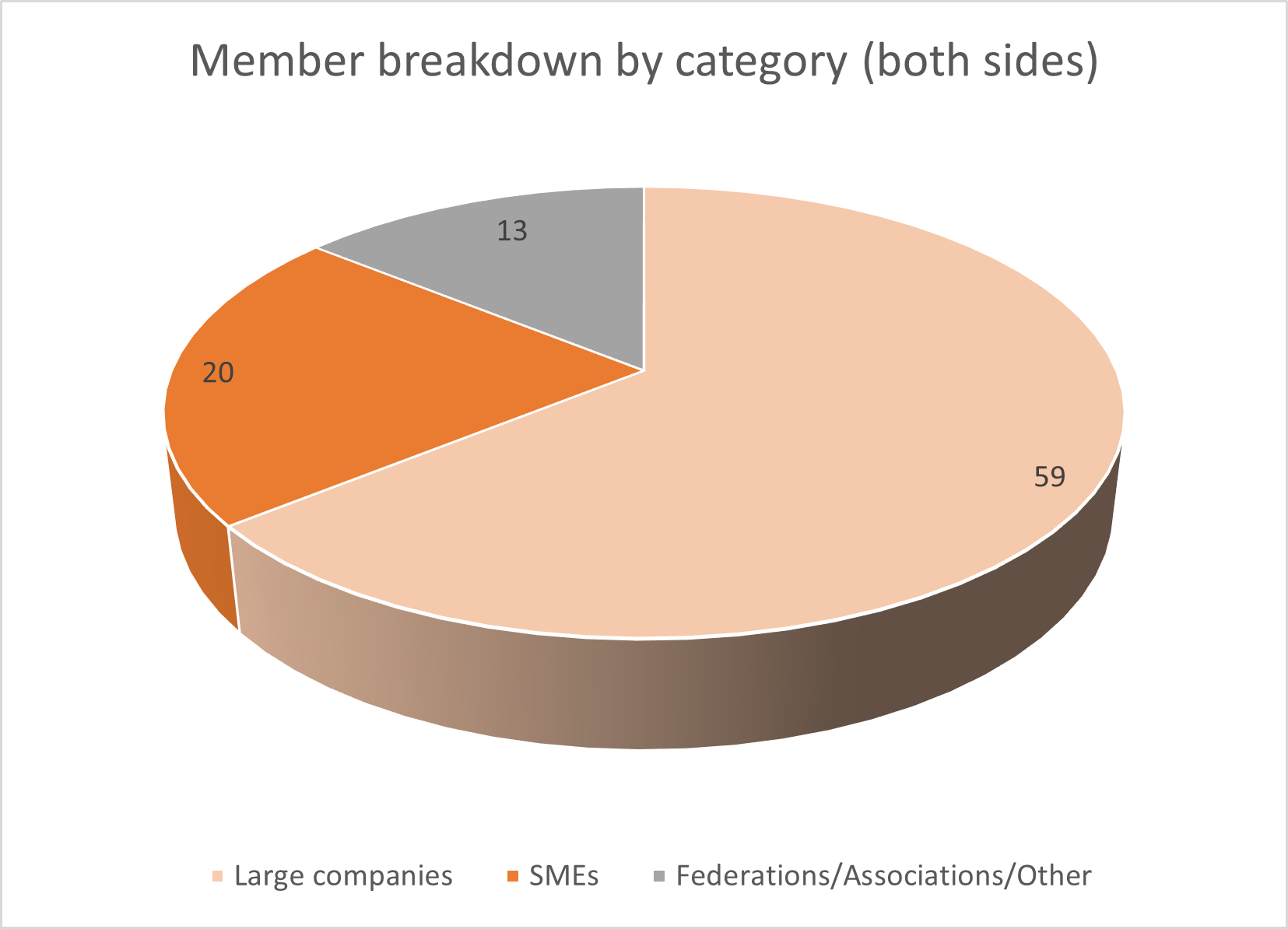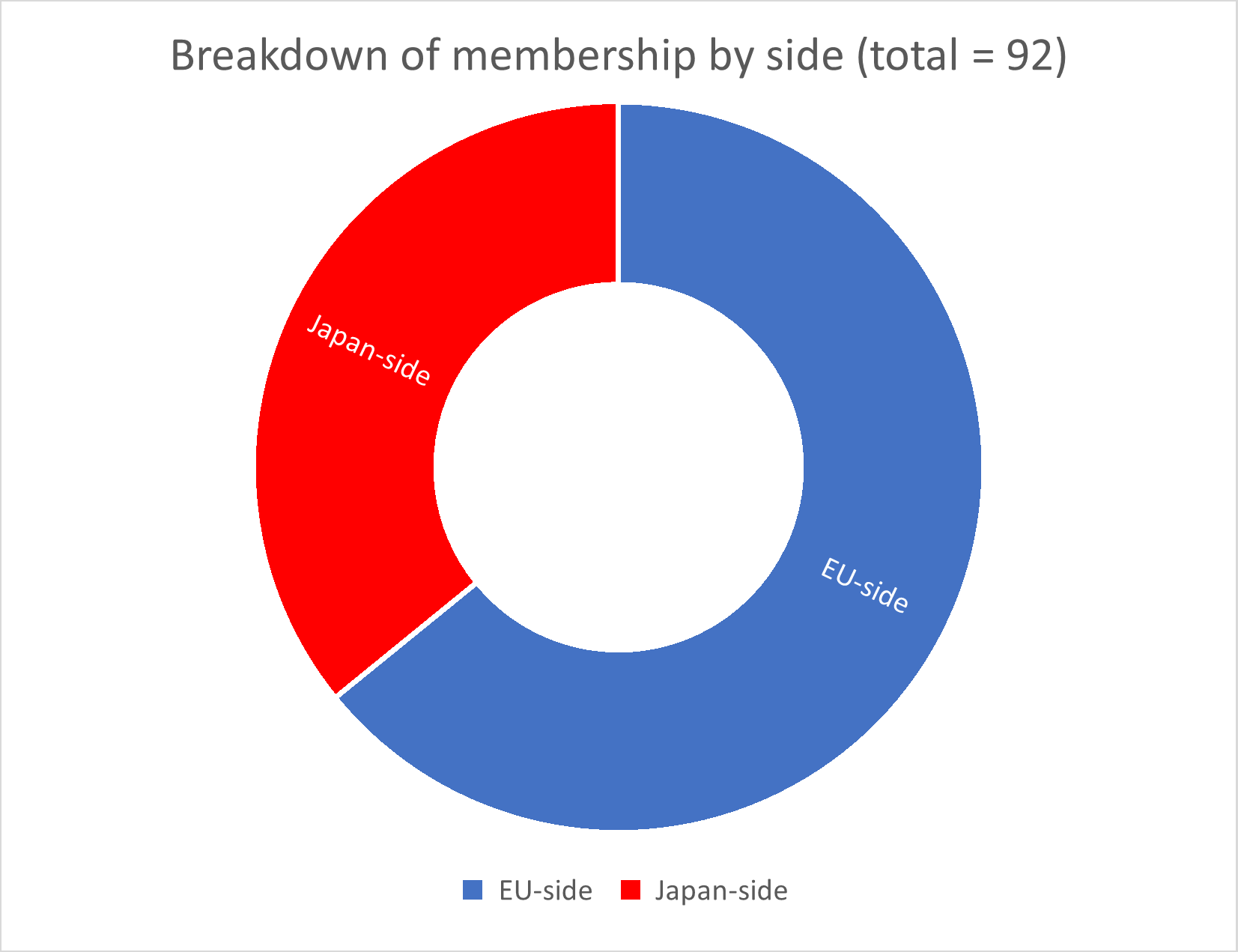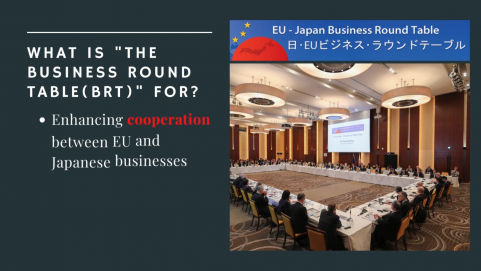
About the BRT
Background
The EU-Japan Business Round Table (BRT) was established in its current form in 1999 to foster communication between Japanese and European industries. It meets annually, alternately in Japan and in Europe, the BRT's most recent meeting was a hybrid one, taking place in Tokyo and online on 12 February 2025. The next one is likely to take place in spring 2026 in Brussels. The BRT was formed from the merger of the "EU-Japan Industrialists' Round Table" and the "EU-Japan Business Forum".
![]() For a 2-minute overview of who the BRT members are, the BRT's goals, working methods, links with the EU and Japanese Authorities and for archive footage, see this introductory video.
For a 2-minute overview of who the BRT members are, the BRT's goals, working methods, links with the EU and Japanese Authorities and for archive footage, see this introductory video.
Who are the BRT's Members?
- The BRT is co-chaired by Nobuhiro Endo (Executive Advisor, NEC Corporation) and by Belén Garijo (Chair of the Executive Board and CEO, Merck)
- Including the co-Chairs, the BRT has 92 Members, all of whom are senior executives from European and Japanese industry.
- Although the majority represent large companies, 20 (more than a fifth) represent SMEs: Ciriot Inc., Cosylab, Cybernetica AS, Energy Pool Japan, Europlan Engineering Services Limited, H3 Dynamics, Iguassu Software Systems, Klingele Chocolade, L4T Group (Life for Tyres) LTD., Linguanomics RD, METRON Japan GK, Nanomakers S.A., Novaptech, SESAMm, Skeleton Technologies, Super Garden and Tox by Design on the EU-side; and euglena Co., Ltd., I.C.O.N. and Spiber Inc. on the BRT's Japan-side.
- There are also 13 business federations, chambers of commerce or other organisations represented: AHK Japan (the German Chamber of Commerce and Industry in Japan); BusinessEurope; CCI France Japon; CEFJ (the French-Japanese Committee for Economic Exchange at Paris Ile-de-France Chamber of Commerce and Industry); Czech Space Alliance; DIGITALEUROPE; the EBC (European Business Council in Japan); the ESF (European Services Forum); GeSI (Global Enabling Sustainability Initiative); GISPRI (Global Industrial and Social Progress Research Institute); the JBCE (Japan Business Council in Europe); Olive Oils from Spain and SMEunited.
- 12 BRT Members (13% of the BRT's membership) are female.
 |
 |
 c. 22% of members represent SMEs, 14% represent federations and the rest represent large companies |
As of 02/04/2025, the BRT has |
Over the past 6 years, the make-up of the BRT has been transformed, with the proportion of:
- SMEs rising from 4% (2017) to c.22% (April 2025).
- Members from federations, associations, chambers of commerce rising from 8% (2017) to 14% (July 2024).
- Female members rising from 0% (2017) to 12% (January 2025).
What does the BRT do?
The BRT's main objectives are to:
- discuss issues of common interest;
- review factors affecting trade, investment and other forms of cooperation;
- provide an EU-Japan business perspective to both topical and long-term issues of public policy; and,
- identify practical recommendations to the Authorities (and support EU-Japan official dialogues) so as to help develop trade and investment between the EU and Japan or together in third markets.
The BRT's recommendations to the Authorities take two forms - its annual 'Joint Recommendations' summarise the collective view of the BRT Members on a range of topics and the annual sets of recommendations prepared by its 4 Working Parties:
- Working Party 1 - Trade Relations; Investment and Regulatory Cooperation; Financial Services, Accounting and Taxation
- Working Party 2 - Life Sciences & Biotechnology, Healthcare & Well-Being
- Working Party 3 - Digital Innovation & Mobility
- Working Party 4 - Environment and Sustainable Development
The EU and Japanese Authorities' responses to the recommendations take the form of oral statements during the annual meeting. The Government of Japan issues formal progress reports to respond to recommendations submitted by the BRT in the previous year. (The European Commission issued similar progress reports up to 2017.)
The BRT currently publicises its work through its annual and ad hoc Joint Recommendations documents. Previously it also published occasional press releases.
How often does the BRT meet?
The BRT holds annual meetings. It also organises occasional web meetings to exchange ideas and information on relevant topics. The next annual meeting is scheduled to take place in Brussels in spring 2026.
The BRT and the EU and Japanese Authorities
A key part of the BRT's work is its exchanges with the EU Authorities and Japanese Government (or"GOJ").
These exchanges take place:
- during the BRT's annual meetings with the participation of senior officials, EU Commissioners and GOJ Ministers;
- via the BRT's annual working party and Joint Recommendation statements;
- through bilateral meetings;
- through the Authorities involving the BRT in official EU-Japan business-to-government stakeholder discussions; and,
- through handover ceremonies, during which the BRT's annual recommendations are submitted (most years) to the Prime Minister of Japan, or (infrequently) to the European Council President and to the European Commission President or to senior European Commissioners.
The BRT is also occasionally referenced in official agreements (e.g. the EU-Japan Green Alliance or Japan-EU Digital Partnership), statements (including press statements from EU-Japan Summits) and other documents published by the EU and Japanese Authorities.
The 3 key Japanese Ministries with which the BRT has contact are:
- Ministry of Economy, Trade and Industry (the METI web archive has pages in Japanese and in English about the BRT)
- Ministry of Foreign Affairs of Japan (the MOFA website has a webpage grouping Japanese-language BRT references from its website. Although an official translation of that webpage does not exist, an English machine translation can be found here. Additional Japanese language and English language BRT references can be found in the MOFA web archive)
- Ministry of Internal Communication (the MIC web archive has Japanese language references to the BRT)
The 3 key Commission departments with which the BRT has contact are:
- Directorate-General for Internal Market, Industry, Entrepreneurship and SMEs (the DG GROW website has a webpage outlining areas of cooperation between DG GROW and METI, including a reference to the BRT)
- Directorate-General for Trade (DG TRADE)
- Directorate‑General for Communications Networks, Content and Technology (DG CNECT)
What was the BRT's position on the EU-Japan Economic Partnership Agreement (EPA)?
Since 2007 - a long time before the formal negotiations actually began - the BRT was in favour of the EU and Japan agreeing a high-level, comprehensive, equitable partnership agreement. In 2007 it convened separate EU and Japan-side taskforces to evaluate the "feasibility" of an "Economic Integration Agreement". Subsequently it followed closely, and gave input to, the negotiations that led to the EU-Japan Economic Partnership Agreement, and issued a statement heralding its entry into force as a "new era for the EU and Japan".
More information
- List of BRT Members
- Full set of BRT annual and ad hoc Joint Recommendations
- The role and work of the BRT's 4 Working Parties
- Documents, photos and details of past annual meetings
- The BRT's terms of reference
- Archived news reports about the BRT and its members
- The BRT and the EU-Japan Economic Partnership Agreement (EPA)
To consult documents adopted and published by the BRT, please either click the above links to see all the documents of a given type (e.g., all Working Party 2 reports, or all Press Releases) or view all the documents relating to a particular meeting in the archive of the "Annual Meetings".
Contact information
The work of the BRT is supported by the EU-Japan Centre for Industrial Cooperation which acts as the BRT Secretariat. For more details about the BRT please contact the EU-Japan Centre either via this web-form or by phone:
- in Europe - Mr. Simon Craig Gray - tel. +32 485 515 901
- in Japan - tel. +81 3 6408 0281










